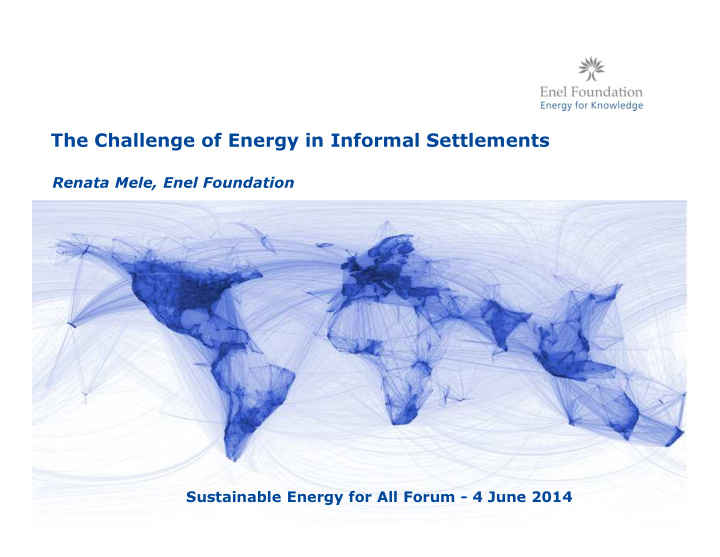



The Challenge of Energy in Informal Settlements Renata Mele, Enel Foundation Sustainable Energy for All Forum - 4 June 2014 1
The challenge of energy in cities � Urbanization is the challenge of our era. Since 2007 more than 50% of the global population is urban. � Cities are: � hub of innovation , growth and improvement in welfare, as well as the place in which cultures, economies, and innovation evolve; � the place that can concentrate some of the worst characteristics of our society in terms of inequality, crime, pollution. � Cities grow and develop by means of energy and resources. The resource flows into cities, and the wastes produced, likely have impacts on a planetary scale . � 1,3 billions people lack access to electricity, 14% of them live in urban areas. � The global urban system emits about 70% of the total GHG emissions. Sustainable energy means sustainable use of energy in cities 2 2
The challenge of energy in informal settlements � Over 830 million of people live in informal settlements, with critical access to modern and basic services: energy, water, sanitation, and education. � People in the lower income bracket generally use low energy efficient and polluting equipment . � Energy in slum is often : � Polluting , every year about 3.5 million people die prematurely because of indoor air pollution by biomass, a significant part of them are in slums � Not affordable , people living in informal settlements usually spend over 30% of their income for energy services. � Unreliable , even in areas connected to the electric grid � Data on energy consumption patterns and emission are poorly existing Sustainable urban development strategy has to include the informal city with its economic and social pattern 3
Use of energy in shanty towns � Low income households use a mix of fuels: � Traditional : dung, wood, agricultural residues � Intermediate : charcoal, kerosene � Modern : LPG, biogas, electricity � Electricity is mainly used for lighting and small appliances In the poorest households, where electricity is not affordable or lacks: � kerosene is used for lighting; � for cooking is used kerosene or charcoal; � Main source of electricity are dry cells and reused car batteries The use of low efficient energy sources produces higher costs paid for the same service 4
Energy consumption and efficiency in informal settlements Research project “ Analysis of energy consumption and energy efficiency in informal settlements of developing countries ”, by Enel Foundation, UN-Habitat, and Politecnico di Milano. � Case studies: Lima and Lagos � Participative approach : local communities are engaged and surveyed on energy use, energy efficiency and overall living conditions. � 400 people surveyed in Lima and 400 in Lagos Expected results � Identify actions, policies, business strategies, and solutions for improving people’s living standards; � Suggest educational activities on energy use and energy efficiency addressed to the local communities. 5 5
Evolution of shanty towns in Lima Jicamarca (Lurigancho) Ventanilla (Pachacutec) Three different development � stages: Early: Jicamarca � Intermediate: Manchay � Advanced: Ventanilla � Manchay (Pachacamac) 6
Informal settlements in Lima: preliminary results in Manchay 7
Understanding the transformation of informal settlements � Informal settlements dwellers are a significant part of the global urban population Their number is expected to grow in the next decades � The transformation of the settlements is related to the evolution of basic infrastructures: electricity, water, transport, and sewage � Quantity and quality of energy use improve with better infrastructures � It is important to understand and forecast the demand of services and future needs of informal communities. � Energy efficiency is a driver for the overall resource efficiency 8
Best practice in Lima: the case of Pachacutec Foundation � Active in the district of Callao (north of Lima) � Promote the development of local communities through Education , Sustainability , and medical assistance � Prototypical case of Creating Shared Value initiative. � Winning case of multi- stakeholder and local population engagement 9
Thank You! Contacts Renata Mele e-mail : renata.mele@enelfoundation.org web : www.enelfoundation.org Address: Via Arno 64, 00198 Rome (Italy) 10
Recommend
More recommend